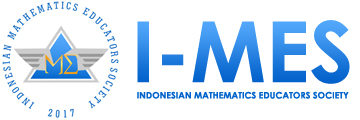THE WAY SUNDANESE GIVE NAMES TO THEIR BABY: CULTURAL ANTHROPOLOGY VIEW IN ETHNOMATHEMATICAL STUDIES
Abstract
The mystery of numbers that were considered to have a role in the mystical dimension has long been practiced since the time of Pythagoras, then known as numerology. Some people in Sundanese tradition believe that numerology brings a lucky influence on their lives and generations. This study aims to reveal how the Sundanese tradition of naming their newborn babies and conduct a phenomenological study on several respondents with unique experiences related to Sundanese numerology in their names. The phenomenon experienced by respondents is seen from the point of view of cultural anthropology. This research was designed using qualitative methods through two approaches, ethnomathematics and phenomenology. Respondents were selected using purposive sampling and snowball methods and obtained 25 respondents scattered around the districts of Ciamis, Banjar, Tasikmalaya, and Garut in West Java. All respondents are expert resources as cultural practitioners in their own culture who can explain the numerology system they used, known as Kasepuhan. The results of the study show that there are many different numerological methods for calculating "lucky names" in the Sundanese tradition that depend on the epistemology of the science of Kasepuhan in their own culture. Most of the calculations involve the concept of integer (modular) operations where each ‘reminder’ represents its own philosophical meaning. Although mathematically the methods of calculating “lucky names†can be learned by everyone, the practice of these calculations is in fact only carried out by people who are considered to have been established from the aspect of science. This article discusses why the mystical phenomenon behind the numerology of the Sundanese tradition cannot be calculated arbitrarily by anyone, people trust more in the numerology calculations performed by Kasepuhan.
Full Text:
PDFReferences
U. D’Ambrosio, “Ethnomathematics and its Place in the History and Pedagogy of Mathematics,†in For the Learning of Mathematics, 1985, vol. V, no. 1, pp. 44–4.
I. Muzdalipah and E. Yulianto, “Ethnomathematics Study: The Technique of Counting Fish Seeds (Osphronemus Gouramy) of Sundanese Style,†J. Medives, vol. 2, no. 1, pp. 25–40, 2018, doi: https://doi.org/10.31331/medives.v2i1.555.
J. Barta and T. Shockey, “The Mathematical Ways of an Aboriginal People: The Norten Ute,†J. Math. Cult., vol. 1, no. 1, pp. 79–89, 2006.
I. Rachmawati, “Eksplorasi Etnomatematika Masyarakat Sidoarjo,†2012.
M. Rosa and D. C. Orey, “Culturally Relevant Pedagogy an Ethnomathematical Approach,†J. Math. Cult., vol. 7, no. September 2013, pp. 74–97, 2013.
F. A. Rohmadina, “Etnomatematika pada Aktivitas Tukang Bangunan Masyarakat Jawa di Desa Kencong,†Universitas Jember, 2017.
Turmudi, “Kajian Etnomatematika: Belajar Matematika dengan Melibatkan Unsur Budaya,†in Seminar Nasional Pendidikan Matematika Etnomatnesia, 2017, pp. 1–17.
Wahyudin, “Etnomatematika dan Pendidikan Matematika Multikultural,†in Seminar Nasional Pendidikan Matematika Etnomatnesia, 2017, pp. 1–20. [Online]. Available: https://jurnal.ustjogja.ac.id/index.php/etnomatnesia/article/view/2290
E. Yulianto, S. Prabawanto, and Wahyudin, “Sejarah dan Filosofis Batik Sukapura: Tinjauan Semiotika,†in Seminar Nasional Pendidikan Matematika Etnomatnesia, 2017, pp. 1–21.
E. Yulianto, Wahyudin, S. Prabawanto, and A. Tafsir, “Some Ethnomathematics Interpretations about the Practice of Dhikr Jahar of Tariqa Qodiriyah Naqsyabandiyah Ma’had Suryalaya,†J. Phys. Conf. Ser., vol. 1477, no. 042032, pp. 1–12, Mar. 2020, doi: 10.1088/1742-6596/1477/4/042032.
E. Yulianto and C. Arumsari, “Nilai Karakter dan Tinjauan Etnomatematika pada Budaya ‘Nyambungan’ Masyarakat Dayeuhluhur,†in Prosiding Seminar Nasional Pendidikan Matematika: Peningkatan Kualitas Pembelajaran Matematika melalui Implementasi Hasil Penelitian, 2016, no. December 2016, pp. 150–166. [Online]. Available: http://www.researchgate.net/publication/331890114
E. Yulianto, Wahyudin, A. Tafsir, and S. Prabawanto, “Contrasting Mathematical Phenomena and Concepts in Ethnomathematics through Etic and Emic Approaches: A Study of Dhikr Jahar Practices in Tariqa Qodiriyah Naqsyabandiyah,†Al-Jabar J. Pendidik. Mat., vol. 12, no. 1, pp. 193–218, 2021, doi: https://doi.org/10.24042/ajpm.v12i1.8805.
P. Gerdes, “Reflections on Ethnomathematics,†Learn. Math., vol. 14, no. 2, pp. 19–22, 1994, [Online]. Available: https://flm-journal.org/Articles/1CC7C4A1B63D66ADF10C6D5AE98E58.pdf
K. P. . Gravemeijer, “Developing Realistic Mathematics Education.†Frudenthal Institute, Utrecht, p. 100, 1994.
A. H. Schoenfeld, “Learning to Think Mathematically: Problem Solving, Metacognition, and Sense-Making in Mathematics,†in Handbook for Research on Mathematics Education Teaching and Learning, D. Grouws, Ed. New Yorl: MacMillan, 1992, pp. 334–370.
A. J. Bishop, Mathematical Enculturation: A Culture Perspective on Mathematics Education, Volume 6. Cambridge: Kluwer Academic Publisher, 1991. doi: 10.1007/978-94-009-2657-8.
U. Dudley, Numerology: Or, What Pythagoras Wrought (Spectrum), 1st ed. United States: American Mathematical Society, 1997.
A. Gregory, “The Pythagoreans: Number and Numerology,†in Mathematicians and Their Gods: Interactions between Mathematics and Religious Beliefs, United Kingdom, 2015, pp. 21–50. doi: 10.1016/B978-044450328-2/50005-9.
P. J. Davis, “A Brief Look at Mathematics and Theology,†Humanist. Math. Netw. J., vol. 1, no. 27, pp. 1–39, 2004, doi: 10.5642/hmnj.200401.27.14.
I. A. Fitriani, A. A. G. Somatanaya, D. Muhtadi, and Sukirwan, “Etnomatematika : Sistem Operasi Bilangan,†J. Authentic Res. Math. Educ., vol. 1, no. 2, pp. 94–104, 2019, doi: DOI : 10.37058/jarme.v1i2.779.
F. F. Nisa, D. Nurjamil, and D. Muhtadi, “Studi Etnomatematika pada Aktivitas Urang Sunda dalam Menentukan Pernikahan , Pertanian dan Mencari Benda Hilang,†J. Penelit. Pendidik. dan Pengajaran Mat., vol. 5, no. 2, pp. 63–74, 2019.
D. Setiadi and A. Imswatama, “Pola Bilangan Matematis Perhitungan Weton dalam Tradisi Jawa dan Sunda,†J. ADHUM, vol. 7, no. 2, pp. 75–86, 2017, [Online]. Available: https://www.jurnal.ummi.ac.id/index.php/JAD/article/download/42/26
Ramli, “Etnomatematika Pada Kebiasaan Orang Sunda Dalam Menentukan Tanggal Pernikahan Dan Kecocokan Pasangan Pengantin,†J. Peka, vol. 4, no. 2, pp. 45–51, 2021, doi: 10.37150/jp.v4i2.842.
D. Handoko, S. Wahyuni, and M. Elsera, “Kepercayaan Masyarakat terhadap Perhitungan Hari Baik dalam Pernikahan di Desa Mampok Kecamatan Jemaja Kabupaten Kepulauan Anambas,†SOJ Student Online J., vol. 2, no. 2, pp. 1472–1487, 2021.
P. Sztompka, Sosiologi Perubahan Sosial. Jakarta: Prenada, 2011.
M. Rosa, “From Reality to Mathematical Modeling: A Proposal for Using Ethnomathematical Knowledge,†California State University, Sacramento, 2000.
Y. Abdullah, S. Maulidia, and A. Amelia, “Eksplorasi Etnomatematika Pada Proses Penentuan Hari Sakral Desa Sambeng di Kabupaten Cirebon,†Histogram J. Pendidik. Mat., vol. 4, no. 1, pp. 428–447, 2020, [Online]. Available: http://fkip-unswagati.ac.id/ejournal/index.php/snpm/article/download/850/399
M. Rosa and D. C. Orey, “Ethnomodeling as a Research Theoretical Framework on Ethnomathematics and Mathematical Modeling,†J. Urban Math. Educ., vol. 6, no. 2, pp. 62–80, 2013, [Online]. Available: http://education.gsu.edu/JUME
F. K. Sari, “The Local Wisdom in Javanese Thinking Culture,†Diksi, vol. 28, no. 1, pp. 86–100, 2014.
D. C. Orey and M. Rosa, “Three Approaches in The Research Field of Eethnomodeling: Emic (local), Etic (global), and Dialogical (glocal),†Rev. Latinoam. Etnomatemática, vol. 8, no. 2, pp. 364–380, 2015.
R. Eglash, A. Bennett, C. O’Donnell, S. Jennings, and M. Cintorino, “Culturally Situated Design Tools: Ethnocomputing from Field Site to Classroom. American anthropologist,†Anthropol. Educ., vol. 108, no. 2, pp. 347–362, 2006, doi: 10.4018/978-1-5225-2005-4.ch007.
H. Qodim, “Kampung Kuta Religion: Social, Economic and Religious Structures of Indigenous Community in West Java,†Wawasan J. Ilm. Agama dan Sos. Budaya, vol. 4, no. 2, pp. 144–160, 2019, doi: 10.15575/jw.v4i2.7746.
H.-C. Yu, “A Comparative Study of the Meanings of Numbers in English and Chinese Cultures,†Intergrams, vol. 16, no. 1, pp. 1804–1808, 2015, doi: 10.4304/tpls.1.12.1804-1808.
P. W. Goetz, Compton’s Encyclopedia (Vol 22). Chicago: Encyclopedia Britannica Inc, 1991.
L. J. Zhmud’, “‘All is number’?,†Phronesis, vol. 34, no. 3, pp. 270–292, 1989, doi: 10.1163/156852889x00189.
U. K. Muttaqi, “Desaign of Converter Hijri Calendar to Ad Calendar for Determaning Islamic Great Days Using Matlab,†J. Nat. Sci. Math. Res., vol. 2, no. 1, p. 109, 2017, doi: 10.21580/jnsmr.2016.1.1.1643.
A. Prabowo, M. Mamat, Sukono, and H. Napitupulu, “The Mathematical Formula for Determining the Name of the Pancawara Day on the Masehi Calendar,†Int. J. Math. Trends Technol., vol. 51, no. 2, pp. 162–166, 2017, doi: 10.14445/22315373/ijmtt-v51p520.
Z. Hadžibegović, “The significance and methods of determination of Kibla, the Holy Islamic direction.,†Anal. Gazi Husrev - Begove Bibl., vol. 13, no. 23–24, pp. 267–180, 2005, [Online]. Available: http://anali-ghb.com/index.php/aghb/article/view/143
U. D’Ambrosio, “Ethnomathematics and Its First International Congress,†ZDM, vol. 31, no. 2, pp. 50–53, 1998, doi: https://doi.org/10.1007/s11858-999-0008-8.
B. Barton, “Ethnomathematics and Philosophy,†ZDM, vol. 31, no. 54, pp. 54–58, 1999, doi: https://doi.org/10.1007/s11858-999-0009-7.
P. Gerdes, “Ethnomathematics and Mathematics Education,†in International Handbook of Mathematics Education, A. J. Bishop, Ed. Netherlands: Springer Netherlands, 1996, pp. 909–943. doi: https://doi.org/10.1007/978-94-009-1465-0_25.
M. Rosa and D. C. Orey, “Symmetrical Freedom Quilts: The Ethnomathematics of Ways of Communication, Liberation, and Art.,†RLE- Rev. Latinoam. Etnomatemática [electronic only], vol. 2, no. 2, pp. 52–75, 2009, [Online]. Available: http://www.etnomatematica.org/v2-n2-agosto2009/rosa-orey.pdf%0AArtÃculo
M. Rosa and D. C. Orey, “Ethnomathematics: The Cultural Aspects of Mathematics Etnomatemática,†Rev. Latinoam. Etnomatemática, vol. 4, no. 2, pp. 32–54, 2011, [Online]. Available: http://www.redalyc.org/html/2740/274019437002/
G. Ritzer and J. Stepnisky, Sociological Theory. London: Sage Publication, 2017.
A. W. Oktiasasi and S. Harianto, “Perhitungan Hari Baik Dalam Pernikahan (Studi Fenomenologi Pada Keluarga Muhammadiyah Pedesaan Di Kecamatan Kertosono Kabupaten Nganjuk),†Paradigma, vol. 4, no. 3, pp. 1–10, 2016.
DOI: https://doi.org/10.37058/jarme.v4i2.3161
Refbacks
- There are currently no refbacks.

This work is licensed under a Creative Commons Attribution-ShareAlike 4.0 International License.
Jurnal Penelitian Otentik Pendidikan Matematika (JARME)
Program Studi Pendidikan Matematika Universitas Siliwangi
Jl. Siliwangi no. 24 Kota Tasikmalaya - 46115
email: jarme@unsil.ac.id
e-ISSN: 2655-7762
Dilisensikan di bawah Lisensi Creative Commons Attribution 4.0 International
StatCounter: Detail
Diindeks oleh :


.jpg)
.jpg)



